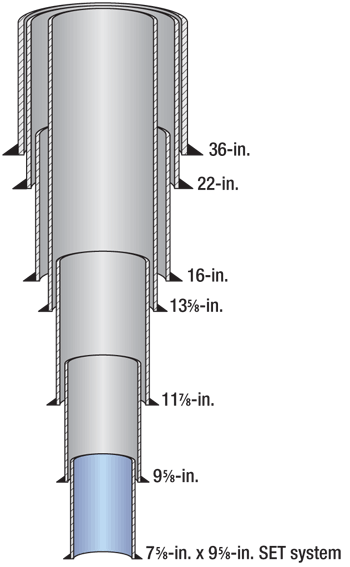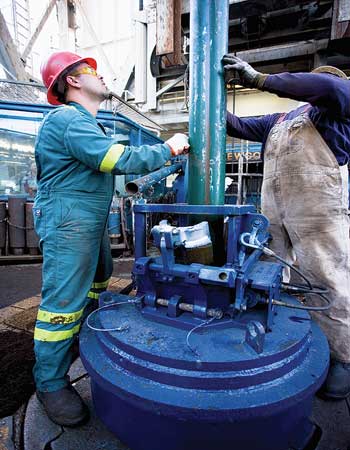A narrow pore pressure window near a higher-pressure zone meant that setting casing and reducing the size of the subsequent conventional string would leave very little room for any event that might force a further reduction in well diameter.
James R. Kunning and Gerald Courville, Anadarko Petroleum Corporation;
and Joe Wallace, Enventure Global Technology
The Shenandoah prospect exploratory well had been fighting severe fluid loss, and it ultimately became necessary to isolate the trouble zone: a low-pressure rubble zone below a higher-pressure interval sandwiched between two salt layers. This Lower Tertiary exploratory well lies in 5,750 ft of water on a Walker Ridge block of the deepwater Gulf of Mexico. The operator, Anadarko, employed what has become an increasingly common, yet innovative, solution to one of the area’s most persistent deepwater drilling challenges: expandable technology. The expandable openhole liner system preserved valuable hole size and important casing options in case other unforeseen hole difficulties were encountered deeper in the well.
Instead of using conventional casing to seal off the trouble zone—which can severely constrain wellbore diameter, limiting evaluation options and even well depth—the expandable openhole liner was installed through the salt. Routine selection and installation of a 1,971-ft expandable liner in the Shenandoah well—the third deepest expandable installation in the world—quickly mitigated the lost circulation problem, saving rig time, mud and materials cost and, most importantly, ensuring much-needed hole diameter at TD.
The application, which used basic expandable technology and procedures, illustrates the maturity of the technology as a standard well construction tool, and provides positive support for planning even more difficult deepwater wells.
SHENANDOAH SUCCESS
The successful Shenandoah well was ultimately drilled to about 30,000 ft. It marked a high point in continued GOM deepwater exploration when it encountered net oil pay approaching 300 ft in the Wilcox Formation.
Standard expandable solution. The decision to run an expandable liner to preserve hole size in the Shenandoah well was supported by broad experience within Anadarko’s drilling department and the industry in general. Anadarko (including Kerr-McGee, acquired in 2006) and Enventure Global Technology have jointly installed solid expandable systems in more than 20 wells worldwide since 2002.
Those installations achieved various objectives, including:
• Thirteen openhole liners to preserve hole size
• Two openhole liners in sidetrack window exits
• One cased-hole liner to remediate casing integrity
• Two cladding applications to case off perforations
• A cased-hole liner to reinforce a production string
• An openhole liner to extend the shoe.
Pipe lengths in these installations varied significantly—from 300 ft to 3,154 ft.
This lengthy historical perspective led Anadarko to incorporate expandables as part of its well control contingency planning. The company purchased two standby expandable casing strings to reduce mobilization costs and expedite drilling hazard mitigation when hole-size preservation was necessary.
The pipe size selected for these two contingency strings (9 5⁄8 x 11 7⁄8 in.) is an expandable system size commonly used in the GOM. While various expandable system sizes are available and have been used in the region, including the 7 5⁄8 x 9 5⁄8-in. openhole liner installed in the Shenandoah well, new sizes are being developed.
Anadarko’s internal experience was buttressed by Enventure’s deepwater expertise. The service company has made 20 installations in waters from 3,400 ft to more than 6,000 ft—many in support of Miocene and Lower Tertiary objectives in the GOM. Still deeper than the Shenandoah expandable liner, which was set at a 28,274-ft TVD, are installations in the Atwater Valley, in 3,430-ft water depth, set at 28,742 ft, and in Green Canyon, in 3,570-ft water and set at 28,555 ft.
 |
|
Fig. 1. A schematic of the Walker Ridge well.
|
|
Since 1998 when it commercialized the technology, Enventure has installed more than 1,100 expandable systems on land and offshore around the world. In total, these installations—which include many contingency applications where severe hole problems already existed—have achieved a reliability rate of nearly 95%. In planned applications, the company’s success rate is nearly 100%.
FLUID LOSS PROBLEMS
The Shenandoah well began experiencing significant lost circulation problems in the days leading up to Christmas 2008. The directional well was six strings deep at about a 28,320-ft TVD, drilling an 8 1⁄2 x 9 7⁄8-in. hole out of a 9 5⁄8-in. drilling liner, when the trouble started.
An already narrow pore-pressure/fracture-gradient window was further complicated when the bit exited a higher-pressure interval bound by layers of salt and entered a deeper, lower-pressure shale rubble zone. When the rubble zone was encountered, it began to allow the costly synthetic mud system to exit the wellbore at a high rate.
Multiple pills with lost circulation material were squeezed over a period of several days; they were unsuccessful at stopping the fluid loss. The options soon narrowed to isolating the problem section behind casing. But running a conventional 7 5⁄8-in. liner to case off the interval would have used a valuable casing point and sacrificed significant hole diameter.
With this option, the 7 5⁄8-in. liner would have been followed with a 6 ½ x 7 ½-in. pilot hole and 5 ½-in. casing. This was unattractive in the difficult environment because another unknown drilling hazard might require yet another unplanned casing point that could critically limit the hole size and therefore the well. The smaller hole also complicated the use of evaluation tools and, potentially, future completion equipment, as well as reduced penetration rates and hole-cleaning efficiency.
The 7 5⁄8 x 9 5⁄8-in. expandable openhole liner provided working room in case another hole problem occurred, by enabling the next hole section to be opened to 8½-in. all the way to TD.
 |
|
Fig. 2. Team members inspect the expandable equipment and pipe at multiple points during the installation process and partner with rig personnel to ensure quality installations.
|
|
EXPANDABLE LINER INSTALLATION
As the lost-circulation scenario began to unfold, service company personnel were quickly brought into the planning process. The drilling and expandables teams collaborated to gather information and develop a plan. The pre-job peer review, which brings in-house experts together to identify and mitigate risk and address any unique installation procedures for the well, proved to be a key aspect of the planning. The operator and other service company personnel often join this review process with the expandables team.
When the decision was made to isolate the trouble interval with an expandable liner, engineers and service technicians were able to respond quickly. A key lesson learned was the value of experienced expandables expertise and the effectiveness of delegating the running operations to planning and installation specialists.
The staged 7 5⁄8 x 9 5⁄8-in. solid expandable openhole liner was prepared at the expandable facility in Katy, Texas, and sent to the operator’s Fourchon, Louisiana, marine dock for mobilization to the rig site. A total of 1,971 ft of unexpanded liner with 57 connections was specified for the installation.
The expandables team was mobilized from Houston on Dec. 25 and traveled to Fourchon, Louisiana, for air transport to the Noble Paul Romano semisubmersible rig. When the team arrived a day later, the rig was squeezing the hole to heal heavy losses. While the expandable liner was being prepared, the rig crew continued to deal with well control issues. Mud weight was about 15.4 ppg, and static bottom hole temperature was 170°F.
Four days after mobilization, the solid expandable system (with the launcher, inner string BHA and expandable anchor hanger) was made up by the rig crew. With the expandable liner ready, the crew began making up the drill pipe and the inner string of the expandable liner system.
During this process, two joints were laid down when the connections were over-torqued. Makeup torque (4,300 ft-lb for this application), which is important to the pressure integrity of expanded connections, was closely monitored by the expandable installation team members. The crew ran the expandable liner in the hole, and the system’s auto-fill float shoe was successfully shifted to the closed position. The team ran the expandable liner into the remaining open hole without any issues.
Once the expandable liner was at depth, mud was circulated to the top of the 9 5⁄8-in. drilling liner. The wiper dart was then pumped into the auto-fill float equipment seat to begin the expansion process. The cementing job was performed, and the dart was pumped by the cement unit for 10 bbl. The rig pumps were then used to pump the dart to completion.
With the dart landed, the expansion process was initiated with 3,800-psi pressure. After 6 hours of pumping time at an average 3,700 psi, the cone exited as anticipated. Setting depth of the liner shoe was 28,281 ft, and the top of the liner was 26,381 ft. The top of the liner was successfully pressure tested to 800 psi for 15 min. Drill-out of the expandable liner shoe was accomplished with a mill-tooth rock bit in about an hour.
A TOOL FOR THE FUTURE
The challenging Shenandoah discovery well benefited from the substantial history of expandable technology in deepwater applications. Application of expandable systems in many difficult, pioneering GOM deepwater wells has yielded a mature technology with high success rates. The maturity of this technology gives many operators the confidence to use expandable solutions as a core technology for well construction.
This routine application of expandables to mitigate what have been long-standing wellbore stability problems proves that well designers now have a reliable tool for future well construction with even greater challenges to overcome. 
A routine enabler
Solid expandable systems are increasingly a routine enabling resource in many wells. A good example is in sidetracking operations, where Enventure has installed nearly 100 expandables sidetracks.
In 2003, Kerr-McGee (now Anadarko) and Enventure installed the first expandable system through a sidetrack window exit. A 7 5⁄8 x 9 5⁄8-in. solid expandable openhole liner system consisted of 52 joints and was deployed through a newly created window in the existing 9 5⁄8-in., 53.5-lb/ft casing. The installation enabled a 7-in. conventional liner to be run through the expanded 7 5⁄8 x 9 5⁄8-in. liner and reach the target zone with the desired hole size.
Use of the expandable liner saved $2.3 million compared to a sidetrack program higher in the wellbore using conventional casing sizes. The use of the expandable liner eliminated the need for retrieving and re-running the subsea tree, resulting in a large part of the cost savings. After the well was drilled and cased, it was immediately completed with stacked gravel packs in the 7-in. production liner and put on production.7
|
THE AUTHORS
|
| |
Jim Kunning, Senior Drilling Engineering Advisor for the Gulf of Mexico and international deep water at Anadarko Petroleum, has nearly 20 years of experience in the oil and gas industry. In the last eight years he has focused on deep water, primarily subsalt wells. He earned a BS in petroleum and natural gas engineering from Pennsylvania State University.
|
|
| |
Gerald Courville, Drilling Superintendent—Deepwater Gulf of Mexico for Anadarko Petroleum, has over 40 years of experience in the oil and gas industry. That experience includes working on the first semisubmersible well for Kerr-McGee and the shallowest horizontal well drilling the Gulf of Mexico. Before joining Anadarko in 1999, Courville worked in a variety of drilling management roles for several operators and service companies.
|
|
| |
Joe Wallace has over 30 years of experience in the oil and gas industry (upstream and downstream). He is a Business Development Manager with Enventure Global Technology. His background includes time with Teledyne Merla, Otis Engineering and Nalco Chemical Company. Wallace earned a Bachelor of Life Science degree from “Harvard on the Bayou,” Nicholls State University. He is active in multiple industry organizations, including serving as an officer for the last five years in the Gulf Coast SPE Drilling Study Group. He currently he serves as the local chapter chairman.
|
|
| |
|




